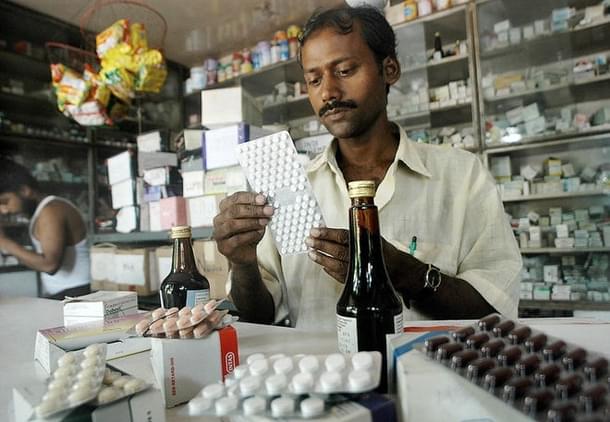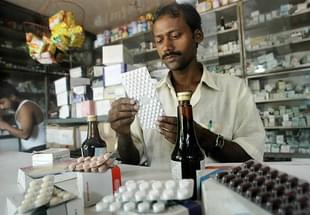Ideas
Jan Aushadhi: Scaling Up Through E-Pharmacy Routes
Samir Kagalkar
Aug 31, 2017, 12:40 PM | Updated 12:40 PM IST
Save & read from anywhere!
Bookmark stories for easy access on any device or the Swarajya app.


The Narendra Modi government has been at the forefront of several structural changes. From the hard infrastructure of roads, ports, airports and mines, etc to the soft aspects of education, cleanliness and health care. Of all these soft infrastructure changes, the Prime Minister has been extremely vocal about the role good health for the citizens. The vision statement of Pradhan Mantri Bhartiya Janaushadhi Pariyojana (PMBJP), providing affordable quality medicine for all, is indeed a very lofty ideal to strive for.
Talking from a management perspective, there are certain key areas that require focus to realise this vision statement.
1. Affordability – this aspect is already implemented by selling generic drug based Jan Aushadhi, whose prices are less than 50 per cent of the branded drugs.
2. Quality – processes have been put in place, wherein suppliers of drugs necessarily comply with ‘good manufacturing practice, benchmarking the product to the global standards of production.
3. Medicine for all presupposes two elements:
a. medicine that are sold across the spectrum, so that all types of medicine that may be required by patients are available
b. medicine to be available across the country in terms of geography
The Prime Minister repeatedly stated that he has taken on the pharma lobby head on by ensuring that profiteering in the healthcare domain is unacceptable and that medical care must become affordable for the common man. A related observation about how the regulator, National Pharmaceutical Pricing Authority (NPPA), swooped in on profiteering in critical healthcare areas like cardiac stent early this year (February 2017) and now in knee implant case (August 2017), shows that the Modi government means business.
However, good intent alone cannot realise the dreams of the Prime Minister. Only an efficient implementation of the scheme will make inroads towards providing top quality affordable healthcare for all Indians.
Among points observed quality and affordability are by and large addressed and taken care of. The key issue that requires focus is ensuring that all medicine reaches all people across the country.
A visual depiction of this issue can be better done with the following 2*2 matrix as applicable to PMBJP-driven generic medicine.
The four quadrants showcase the various stages of target achievement:
Quadrant One - Proof Of Concept
To make sure that quality medicine at affordable prices can indeed be provided, a few medicine (say around 100 to start with) in a few places (say 100 locations across India) would be part of the launch phase. By the time this idea was conceptualised and launched or implemented in 2013, there were roughly 90 kendras with about 85 kinds of medicine being supplied. The evaluation committees that went into the details of this programme found this to be ineffective in serving the objective of the initiative for various reasons, though as an idea this was considered very powerful. Read more about it here.
As far as proof of concept is concerned, it has been successfully proven, though it surely can be bettered.
While the stated objective is to reach quadrant four, either it can take the route of Q 1 > Q 2 > Q 4 (meaning open PMBJP stores all over India, offering a large cross section of medicine) or Q 1 > Q 3 > Q 4 (reach out all over the country immediately via e-pharmacy route with only few medicine before stabilising and slowly build up the number of medicine, leading to the ideal situation). Or a combination of routes Q 3 and Q 2 to effectively reach Q 4 (this means, there will be a good number of physical stores, while predominantly e-pharmacy will be the route to deliver)
The Current Problem
The current thinking and implementation, from 2014 till date, seems to be more on the route via Q 2 (viz open more physical kendras). From the 80 odd kendras inherited in 2014, the Bharatiya Janata Party (BJP) government has done exceedingly well to ramp up to over 2,600 kendras with an intent to reach 3,000 kendras by the end of 2017 (looks very feasible and is a highly commendable task). While this looks exceedingly great in comparison to the previous United Progressive Alliance (UPA) record, when mapped against the big target of ‘healthcare for all’, this is woefully short of anticipated achievement even by the next decade.
The inherent instability due to provision of subsidies for sustaining this venture is very evident (imagine the subsidy of Rs 1.5 lakh per kendra over 1 lakh kendras, if that is the only route to be adopted – and not to speak of the inherent economic dis-incentive for an entrepreneur, if the price of Jan Aushadhi is less than 50 per cent of the branded drug). The long term success is completely dependent on how sustainable these kendras can be instead of being dependent on subsidy given by the government.
At the current roll out rate, by 2019 one can expect the Modi government to roll out around 10,000 Jan Aushadhi kendras across India. Just as a comparison, there are over 10.5 lakh chemists who are already in operation today. Meaning, less than even 1 per cent of regular chemist number would be reached by Jan Aushadhi kendras. This by no stretch of imagination can be assumed to be able to realise the vision of Prime Minister Modi. In other words, moving from Q 1 to Q 4 via Q 2 (opening large number of physical kendras and over time cover the whole country) looks impractical, to say the least.
The other option left for the government is to tap the advancements in the field of technology and leverage the digital India policy of the government. It has been a strong belief for the Modi government that digital India is the way ahead in many of the key areas that are hampered by bottlenecks.
The e-pharmacy route (move from Q1 to Q4 via Q3) looks like the only option left to reach the goal of affordable quality healthcare for all. While the entrepreneurial ventures in the e-pharmacy domain are already operational (1MG, Netmed etc), FICCI and other industry bodies have made a strong case for enabling e-pharmacy to serve the larger cause of healthcare provision (this is for the for-profit firms and even there, efficiency gains would be very high, leading to lower prices for patients soon). Therefore, as a strong proactive initiative, the government may take the following steps to get its healthcare for all policy moving ahead on e-Jan Aushadhi.
1. Focus on the key, critical non-communicable diseases, which are spreading by the day and require long term/life-long treatment. Cardiac issues, blood pressure and diabetes can be the three focus diseases to start with.
2. The total number of all unique patients taking medication for these three diseases is around 20 crore and expected to increase with ageing population.
3. All patients across the country who require these medications can be targeted and this process can be stabilised before entire range of medicine can be delivered via e-Jan Aushadhi mode, reaching the entire 125 crore population
4. That would be the reaching of Q4 (affordable healthcare for all) as the intended goal of the Prime Minister.
5. Presence of over 10,000 physical kendras especially in very backward areas (even if they are just 1 per cent compared to the regular chemists) would very nicely complement the online presence, leading to mutual reinforcement (so to reach Q 4, a pre dominant Q 3 along with a supporting Q 2 is required).
With the booming of e-commerce in India, players like Amazon and Flipkart have already made a big bang statement of their ability to deliver goods anywhere in the country. Their logistics capability is not only extremely reliable and cost effective, but is already ready for use immediately. If speed is of essence for the Prime Minister, then leveraging partnership with these firms is more meaningful. Add to this, the digital payment being adopted in a big way by the country. A potential foundation has already been laid for e-Jan Aushadhi to take off!
The draft policy of pharma, under discussion till the end of August 2017, already has an action point mentioned in this aspect. The challenge is to gather top speed and deliver instead of dragging one’s feet. Create a proof of concept for the stated few medicine (for the three key diseases as stated above) and ramp up the sale of medicine so that over the next 18 months, Prime Minister Modi’s dream of affordable quality healthcare for all becomes a reality.
The biggest beneficiary in this will be BPPI (Bureau of Pharma PSUs of India). This nodal organisation can purely focus on procurement of top quality generic medicine while leaving the nitty gritty of logistics to experts (logistics players in the private sector) instead of trying to run thousands of kendras all over the country, with lesser effectiveness and huge subsidy burden.
The FICCI document making case for e-pharmacy surely has a significant role to play in days to come. In which case, it is merely a matter of leveraging the existing resources in our economic ecosystem to deliver a key social need that was left undelivered for the good part of 70 years since Independence.
What better way than to leverage digital India for delivering medicine? Will Pharma Policy 2017 bite the bullet? Prime Minister Modi and the entire country will be interested to know.
Dr. Samir Kagalkar holds a PhD from IIM Bangalore (Corporate Strategy and Policy). Currently he is serving the Government of India as an Additional Private Secretary to Union Minister for Chemicals & Fertilizers. Views are strictly personal and may not necessarily reflect the views of the Minister, Ministry / its departments or that of the Government of India.
Dr. Samir Kagalkar is State Convener of BJP Economic Cell Karnataka and holds a PhD from IIM Bangalore.





